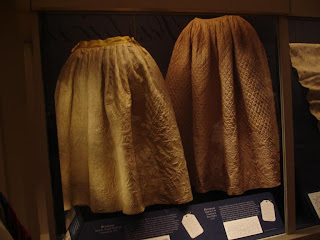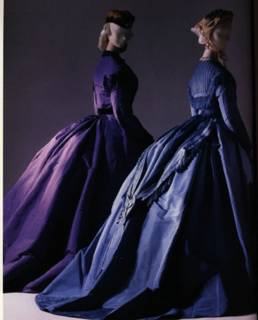I went down to
Williamsburg this weekend for yet another fabulous
Burnley and Trowbridge workshop. For this workshop, we were constructing backs made out of four pattern pieces, and then fronts that were either sectioned or had drawstrings (like the late 18
th century chemise dresses).

Here, I'm at work draping the back of my fitting partner's gown.

These were the pattern pieces that when my partner draped the gown for me. A 'quartered back' or four pieces make up the back of the dress. This back style was the basic difference between the Robe
Anglaise and the draping back of the Robe
Francaise.

Here's a photo of me once we finished draping the front of the dress.

Finally it was time for
pinning and fittings.

Many of the dress pieces are simple pinned together at this point, but the back has been completely assembled and finished. This is what the back of the gown will look like (I'll cut a rectangle of fabric...probably 108 inches long, and pleat it until it fits into the dress. The skirt sews right onto the finished bodice).

Here's what the front looks like. The stripes are supposed to do that - I didn't mess up when I cut them. You can see the line where they have been pieced together. I'm doing to cover that line with some trim to dress it up a bit. This is what I walked away from the weekend with - I have more sewing to do to finish up assembling the bodice, and the it's up to me to figure out the skirt and petticoat. I'm pretty confident I can do it.

The owner of the Silly Sisters was at the workshop, and brought a period gown from her own collection for us to look at. The stitches were amazing, and it was interesting to see how the seamstress worked with what she had, piecing where she needed to.

Here is a close up of the trim. As usual, I love the pinked edges. How pretty! Amazing that it has survived for over 300 years.

There is talk of
beginning 1812 workshops so that we'll all be ready for the 200
th anniversary of the war of 1812. In honor of this, we got to see a replica of early 19
th century stays. Given how much trouble I had making mine, I might take this course if they decide to offer it.

There was lots and lots of inspiring costumes on display this weekend. I love this cap made out of silk gauze (what we could call organza today).

The color and detailing on this jacket and petticoat combination are simply gorgeous!

I especially liked the back - it's a pet-en-
l'air with a hood. I had never seen that combination before.

Here is a quarter back
round gown, worn by one of the ladies that works in the Milliner's shop in
Williamsburg. I love the little detailing at the bottom of the dress and the sash.

This gown has the
drawstring front that was one of the options in this course. The gown is based off of a portrait that we were shown during the workshop - it's a dead ringer for the original, right down to the purple hem.

This is
Janea Whitacre, Mistress and Mantua-Maker of Colonial Williamsburg, the teacher for this workshop. She's wearing a beautiful zone gown with a raspberry colored petticoat.
I love how the stripes on the
indian print cotton worked out in the back. The bunching that you see is because she is wearing the back bustled up. In the 18
th century, this was called a gown "En Polonaise."

Sarah, the apprentice at the Milliner's shop, is wearing a chemise gown with a drawstring front. I LOVE the sash she is wearing. Her hair is styled in the fashionable '
hedgehog' style of the later 18
th century.

On Sunday, Dave went
to the museum in
Williamsburg (somehow neither of us had ever made it there). He wound up on a once a week special tour of the historical fashion display and was very thoughtful and took pictures for me. Pictured above is an amazing stomacher - all the trim and detailing is just amazing.

These are silk quilted petticoats (they would have been worn on the outside of the garment as a skirt...this was not an undergarment).

The green skirt under the red is quilted, but that is lost in the photo. However, I thought that the red gown was pretty.

Here is a quilted petticoat that is meant to be worn as an
under petticoat (undergarment). The stays are a late 18
th century style (one of the girls in my sewing group made this pair of stays in her own size). They give a bit more of a curve to the front of the body, instead of the ridged straight front that earlier corsets provided.

This is an example of the ridged, full boned pair of stays that would mold your body into a triangle torso, and the front is ridged and flat. The keen observer will note that these are the exact pair of stays my blue 18
th century stays were patterned from. I actually have the pattern pieces that would create this corset in the size shown here. Pretty neat, huh?
 I was very happy with the way the back turned out. I love the little square formed by the shoulder straps and the nice point at the base of the bodice. And look at how well it's fitting...it's like it was made for me (*gasp*). The hardest part was repining the shoulder straps (Dave was a big help on this) and setting the sleeves into the bodice. Thank goodness for him, because my fitting double was pretty much worthless. My stays couldn't take the strain of squeezing the foam form (I apparently have more of a 'squish' factor than my foam form does).
I was very happy with the way the back turned out. I love the little square formed by the shoulder straps and the nice point at the base of the bodice. And look at how well it's fitting...it's like it was made for me (*gasp*). The hardest part was repining the shoulder straps (Dave was a big help on this) and setting the sleeves into the bodice. Thank goodness for him, because my fitting double was pretty much worthless. My stays couldn't take the strain of squeezing the foam form (I apparently have more of a 'squish' factor than my foam form does). So here's the dress as I wore it on Saturday night. The fabrics match, so it's kind of hard to see, but there is an underskirt that is separate from the dress, and then an over skirt which is pleated and sewn into the bodice.
So here's the dress as I wore it on Saturday night. The fabrics match, so it's kind of hard to see, but there is an underskirt that is separate from the dress, and then an over skirt which is pleated and sewn into the bodice. One of the things I'll need to redo is the hem of the over skirt which is a bit too long in a few placed. Then I would like to trim the dress on the bodice and at the sleeve edges. I'm still debating adding a flounce to the under-petticoat, but there's something very nice about it's current simplicity.
One of the things I'll need to redo is the hem of the over skirt which is a bit too long in a few placed. Then I would like to trim the dress on the bodice and at the sleeve edges. I'm still debating adding a flounce to the under-petticoat, but there's something very nice about it's current simplicity. Here's the back. I'll need to hang the dress on my fitting double to make sure that something funny isn't going on with the pleats on the left side of the bottom point, but for the most part I'm very happy with how the over skirt pleated into the bodice.
Here's the back. I'll need to hang the dress on my fitting double to make sure that something funny isn't going on with the pleats on the left side of the bottom point, but for the most part I'm very happy with how the over skirt pleated into the bodice. I took this shot from the side so you could see the silhouette that was popular towards the later part of the 18th century. I'm wearing a false rump. I tried my best to style my wig in the popular 'hedgehog' look. The silk ribbon in my hair is eventually going to be made into a belt for this outfit. I should still have enough leftover silk to use in my wig for a decorative touch.
I took this shot from the side so you could see the silhouette that was popular towards the later part of the 18th century. I'm wearing a false rump. I tried my best to style my wig in the popular 'hedgehog' look. The silk ribbon in my hair is eventually going to be made into a belt for this outfit. I should still have enough leftover silk to use in my wig for a decorative touch. Just for fun, here's a photo of me in my cape, ready to walk out the door. I need to make a pocket for this outfit - I had nowhere to carry a camera, so unfortunately I don't have any pictures from the ball. There were some amazing outfits and wigs that I really wish I had photos of, but I'll just remember that for next time.
Just for fun, here's a photo of me in my cape, ready to walk out the door. I need to make a pocket for this outfit - I had nowhere to carry a camera, so unfortunately I don't have any pictures from the ball. There were some amazing outfits and wigs that I really wish I had photos of, but I'll just remember that for next time.































